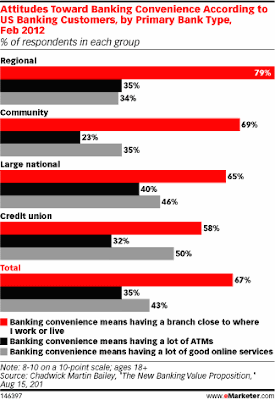Recently, however, small institutions have been working on ways to erode this advantage, closing the gap through expanded ATM networks, improved online banking and now mobile banking services. In short, technology is quickly changing the definition of convenience for bank customers.
A recent study, The New Banking Value Proposition, from market research firm Chadwick Martin Bailey, finds that credit unions and smaller banks are maintaining their perception of having high levels of personalized service while also catching up with their larger competitors in terms of banking convenience. For those smaller institutions who are focusing on new technologies, this can allow them to more effectively compete for the increasing number of accounts in motion. Additional findings include:
- While 42% of consumers state that they use a large national bank (21% regional, 13% community, and 21% credit union), the tenure of relationship (and the value received) is inversely correlated to the size of organization.
- Online and mobile banking have quickly become key components of banking convenience. While consumers still value the branch and ATM access, 43% agree that banking convenience and having good online services are synonymous. As shown below, while large bank customers place a higher value on branch and ATM convenience, the customers of credit unions place a higher value on online services. It is expected that mobile banking service convenience will mirror or surpass the convenience value of online banking in the future.
- Somewhat surprisingly, the research found that credit unions receive very high marks on the access to and performance of new technologies from their customers. While some of this rating may be related to the type of services desired through online and mobile channels by credit union customers (balance inquiries as opposed to more sophisticated uses), this does go against the typical perception of credit unions being less technologically advanced. It should be noted, however, that community and regional banks did not fare as well on technology performance.
I questioned Jim further around the introduction of new technologies in the mobile wallet and payment areas, and whether this may make differentiation between larger banks and their smaller competitors even less pronounced. Garrity responded, "The speed of technology adoption at credit unions and smaller banks is definitely quickening, but larger banks continue to have the advantage of being able to build this functionality 'to order', whereas small banks and credit unions need to purchase this functionality 'off-the shelf.' So, while the pace of implementation is undoubtedly quickening, that doesn’t mean that big banks don’t retain the advantage being able to get there first."
Finally, I wondered if digital innovation and the importance of 'have it now' convenience could be the Achilles heel for an entire segment of the industry? Jim believed that what all banking players need to worry about is if banking is following the same path as bookstores —where many small players were selling a commodity product, then the conglomerates (the Barnes and Nobles and the Borders) dominated and forced many small bookstores out of business except in those cases where the business wasn't valuable enough or there was an unserved niche.
According to Garrity, "What we have here is that several players are vying to become the next 'Amazon of banking,' with an online presence supported by products produced by others (i.e. Simple and Movenbank)."
There is no doubt that this research, combined with the learnings of the bookstore industry, provides some lessons to be learned from around the changing nature of convenience, the impact of commodity price pressures, the importance of service differentiation, and the relevance of community connections, etc. The key will be whether the distribution disruption continues at the same pace, how consumers will respond to the changes in the marketplace, and whether banking can alleviate concerns around security and perceived risk with digital channels.
Video overview of The New Banking Value Proposition





No comments:
Post a Comment